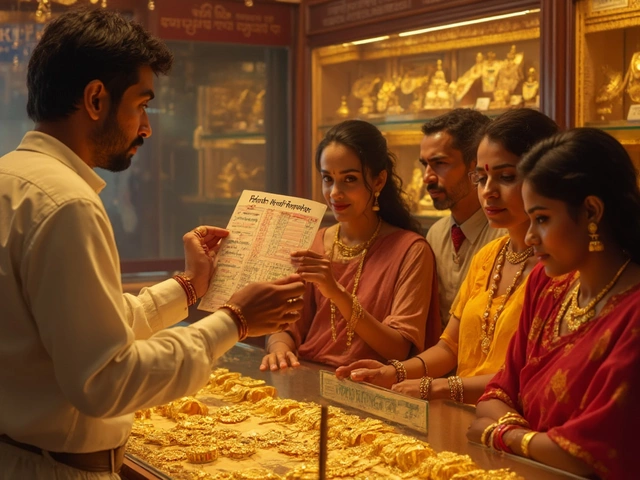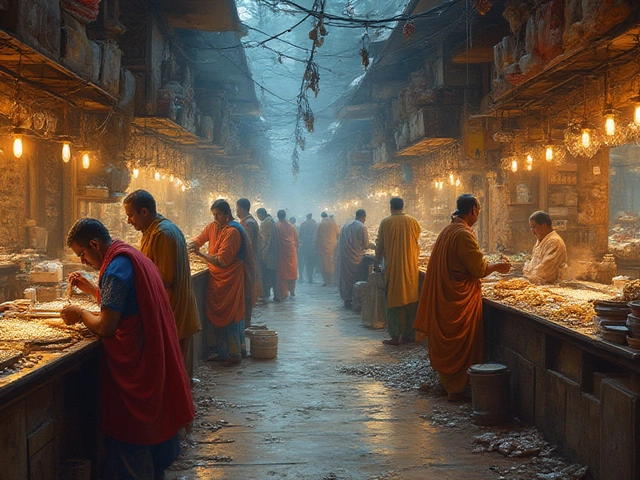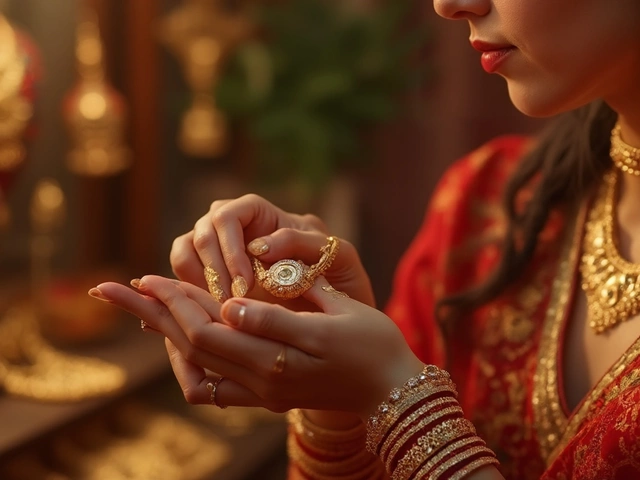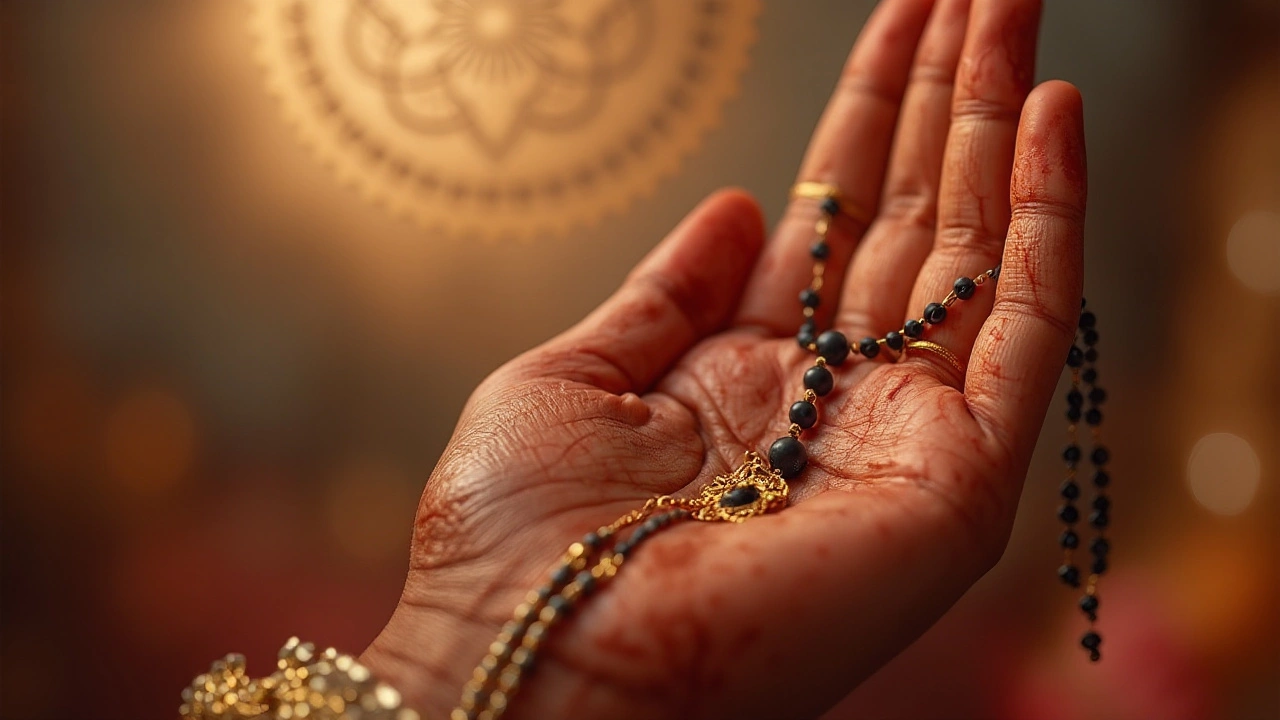
In the realm of Indian tradition, the Mangalsutra holds a vital place, particularly in Hindu weddings, symbolizing the sacred bond between husband and wife. This ornament, draped around the neck of the bride, isn't merely a decorative accessory but a profound emblem of marital devotion and societal obligation. At the heart of this sacred thread are its three knots, each imbued with meaning and responsibility.
The roots of the Mangalsutra run deep into ancient customs, where it is believed each knot has a purpose: securing the promise of love, trust, and commitment. These aren't just philosophical ideals but represent a tangible way of expressing the intricacies of marriage. Journey with us through the cultural tapestry and hidden artistry behind these revered knots, revealing their importance in both personal and traditional contexts.
- Historical Background of the Mangalsutra
- Symbolism of the Three Knots
- Cultural Significance in Indian Marriages
- Design Variations Across Regions
- How to Choose the Perfect Mangalsutra
- Caring for Your Mangalsutra
Historical Background of the Mangalsutra
The Mangalsutra stands as a timeless symbol within Hindu marriage rituals, echoing traditions that stretch far back into the annals of history. Its origins are believed to date back to the 6th century AD, within the socio-cultural framework of Southern India, where the earliest references are found in ancient Tamil and Kannada literature. These references suggest that the ritual of tying this sacred thread was integral to wedding ceremonies, symbolizing not only the sanctity of marriage but also a transition into the duties of married life. The name itself merges two significant Sanskrit words: 'Mangal,' which means auspicious, and 'Sutra,' meaning thread, thus conveying the message of a holy bond created by marriage.
Throughout the centuries, the design and composition of the Mangalsutra have evolved, yet its essential purpose remains unchanged. Originally fashioned from cotton threads dipped in turmeric and later gold and black beads were added for ornamental appeal and supposed protective powers. It's fascinating to note how the strands in the Mangalsutra initially served practical roles, believed to ward off evil spirits and protect the marital union. The historical metamorphosis from a simple sacred thread to an elaborate jewelry piece demonstrates the adaptability of traditions, marrying functionality with artistic expression. "The roots of the Mangalsutra's tradition showcase the seamless blend of spirituality and personal touch," said Dr. Rekha Sharma, a renowned historian in Indian cultural studies.
The evolution of Mangalsutra is a narrative about its role as a protector and emblem of love throughout tumultuous times, keeping the essence of marital spirituality intact.
As the Mangalsutra transcended regions, it absorbed local customs and styles, leading to a variety of designs which reflected the diversity found within Indian beloved cultural fabrics. In Maharashtra, for example, the Mangalsutra includes two vatis or cups, symbolizing Shiva and Shakti, imbuing the piece with divine connection. Whereas in Karnataka, the focus might be on the simplicity with the poignant 'Karimani' design prominent in weddings, emphasizing minimalism yet profound significance. This geographic diversity underlines the unifying yet individual nature of India's matrimonial traditions. The journey of the Mangalsutra from its origins to its modern interpretations is not just about adornment but is emblematic of the social evolution and the resilience of cultural practices across the ages.
Symbolism of the Three Knots
The traditional Mangalsutra is much more than just a piece of Hindu bridal jewelry; it is a deeply symbolic representation of marital unity. The essence of this sacred thread lies in its three knots, each intricately woven with profound significance, reflecting not only love but also numerous responsibilities and spiritual beliefs dear to Hindu culture. The first knot is often associated with the union of the couple – a sacred promise that binds their destinies together in this lifetime and beyond. This knot signifies the deep love and mutual respect that forms the cornerstone of a successful marital relationship. It is an embodiment of the emotional bond that will keep them connected through the highs and lows of life.
The second knot is a reminder of the couple's duty towards their family and household. In Indian society, marriage is seen as a gateway to numerous social responsibilities. Couples are expected to manage their household, contribute to society, and nurture the next generation. This knot symbolizes endurance, patience, and the effort required to maintain a harmonious family life. It's a representation of the transition from individual independence to shared responsibilities, guiding the couple to uphold familial values and traditions.
The third knot holds spiritual significance, representing the couple's dedication to achieving spiritual growth and attaining higher consciousness together. It symbolizes the journey towards enlightenment and self-realization, encouraging the couple to support each other in both personal and spiritual endeavors. In this context, marriage is considered not just a worldly affair but a spiritual alliance that aids in the pursuit of life's ultimate goals.
The Mangalsutra serves as a constant reminder of the vows of a Hindu marriage, echoing sentiments expressed by Swami Vivekananda, who emphasized the spiritual growth attainable through committed relationships. "Marriage is a necessary need of humanity to achieve spiritual harmony," he notably articulated, underscoring its dual role as a worldly and spiritual journey.
Each of the knots in a Mangalsutra intertwines the physical, emotional, and spiritual layers of life, thus encapsulating the comprehensive essence of what it means to be married. It's a reminder to many that love is not just a singular promise but a tapestry of commitments, each thread as significant as the next. The cultural practice of tying these three knots in a Mangalsutra is filled with ceremony and reverence, turning what might seem like a simple act into an event of deep spiritual significance. Through these knots, the Mangalsutra embodies the continuum of life's journey from emotional connection to spiritual alignment, reminding us all of the deep roots marriage has within our cultures and hearts.
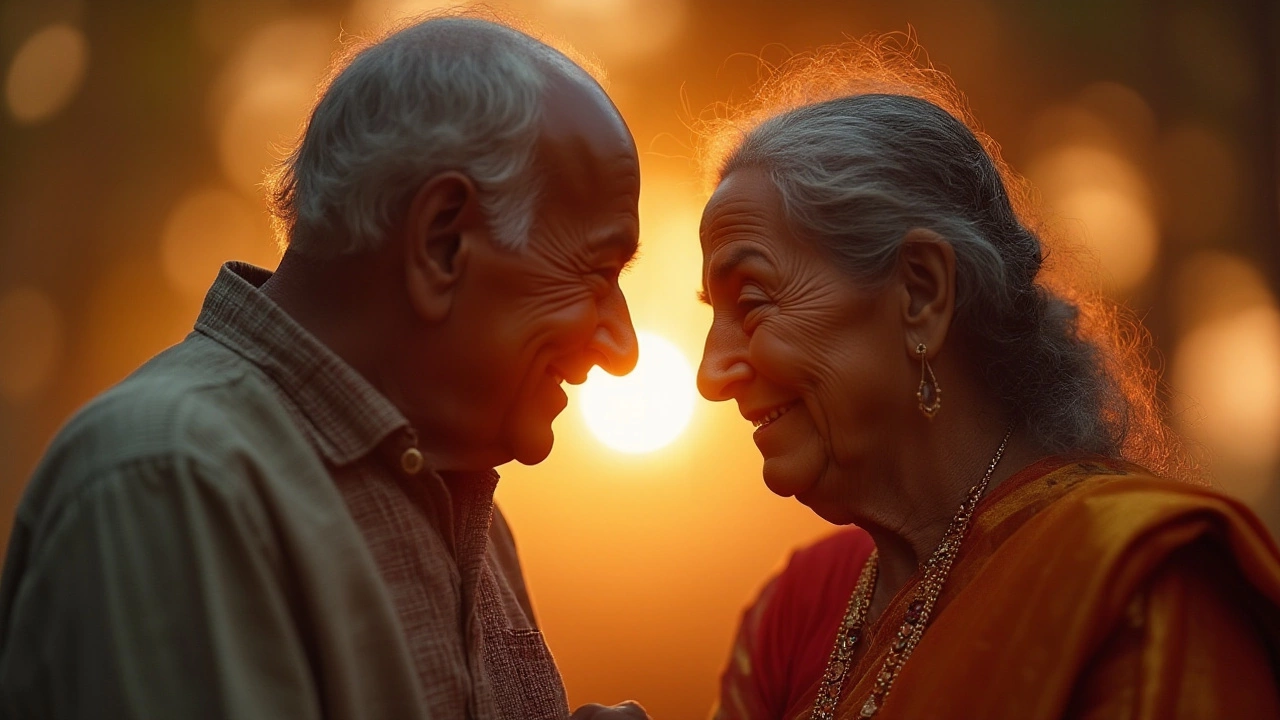
Cultural Significance in Indian Marriages
In the tapestry of Indian weddings, the Mangalsutra is not a mere accessory but a potent cultural symbol that embodies the sacred connection between two individuals. The tradition of tying the Mangalsutra is steeped in ancient Hindu customs, representing a custom that has traveled through the sands of time, retaining its essence and increasing its significance with each passing generation. For a bride, it marks her transition into married life, with each of the three knots signifying not only the union of two souls but also her integration into her husband's family. This piece of jewelry is a pledge of protection, love, and unity, worn typically throughout her life.
The importance of the Mangalsutra varies slightly across different communities and regions within India, yet its core symbolism remains unshakable. In many Hindu communities, especially among Gujaratis and Marathis, the Mangalsutra is considered so as sacred as the wedding vows themselves. Each component of the Mangalsutra carries a burden of meaning — the black beads are believed to ward off negative energies and protect the sanctity of the marriage, while the gold symbolizes prosperity and well-being.
The inclusion of three knots within the Mangalsutra ritual encompasses both literal and metaphorical dimensions of marriage. The first knot is typically tied by the groom, dedicated to the physical and emotional unity of the couple. Following this, the second knot represents the commitment to household duties, nurturing, and creating a harmonious family life together. The third symbolizes spiritual union and growth, urging both husband and wife to support one another in reaching personal and spiritual milestones.
"The Mangalsutra holds a space within the traditional wedding ceremony that is both ceremonial and functional - it binds the spouse in love and trust while holding the families together." - R. Singh, Cultural Historian
The Mangalsutra's design, often varying with regions, is a testament to India's diverse culture. While northern regions might favor simpler styles focusing on elegance, southern India sees intricate designs featuring temple coins and unrivaled beadwork. This diversity signifies that marriage, while universally binding, is celebrated distinctively across cultures. Understanding these cultural values enhances the Mangalsutra’s role as not just a jewel but a living legacy that continues to resonate with profound cultural significance within Indian bonds of matrimony.
Design Variations Across Regions
The Mangalsutra, while universally recognized within Hindu culture, showcases a rich diversity in designs that reflect the cultural nuances of various Indian regions. This sacred thread not only connects two individuals in matrimony but also mirrors the intricate tapestry of Indian heritage. Whether you're exploring the elegant simplicity of designs from the North or the elaborate craftsmanship from the South, each style narrates a unique story of tradition and artistry. In Maharashtra, for example, the Mangalsutra often incorporates two hollow gold cups, known as vatis, which signify the harmony in married life. These are flanked by black beads that are believed to keep away evil spirits, a feature common across many designs in India.
Traveling southwards, one encounters the Nallapusalu style from Andhra Pradesh. This version often boasts an opulent display of gold and black beads, symbolizing the goddess Lakshmi and prosperity. Here, the design is reflective of not just spiritual beliefs but also the local taste for lush and elaborate ornamentation. In Tamil Nadu, the design evolves to feature the Thaali, a flat, leaf-like pendant which sometimes bears engravings of religious symbols like the deity Shiva. This piece is among the most revered, made using age-old techniques passed down through generations. According to jeweler Anjali Raman, "The Thaali's significance is deeply spiritual; it is much more than a mere embellishment – it's a talisman of protection and fortune."
In Gujarat and Rajasthan, the Mangalsutra may take on a more minimalistic style, often with geometric patterns that reflect the tribal influences of the region. The style here is less about adornment and more about the balance and symmetry, mirroring the desert landscapes and the simplicity of life. In the east, particularly in West Bengal, the Mangalsutra might include elements like coral or pearls, emphasizing the tendency towards vibrant and contrasting colors typical of the region's artistry. Such variations underscore the adaptability of this ornament over centuries, shaping itself to align with local craftsmanship and the lifestyle of its wearers.
Additionally, the significance of the Mangalsutra in contemporary fashion cannot be overstated. Designers today are blending traditional elements with modern aesthetics to appeal to younger generations. You find Mangalsutras that might feature understated diamond settings or are reimagined as delicate, chain-like necklaces suitable for everyday wear. Despite these changes, the fundamental components – the black beads and the triple-knot symbolism – remain intact. This balance of old and new ensures that while tastes might evolve, the essence of this matrimonial emblem lives on.
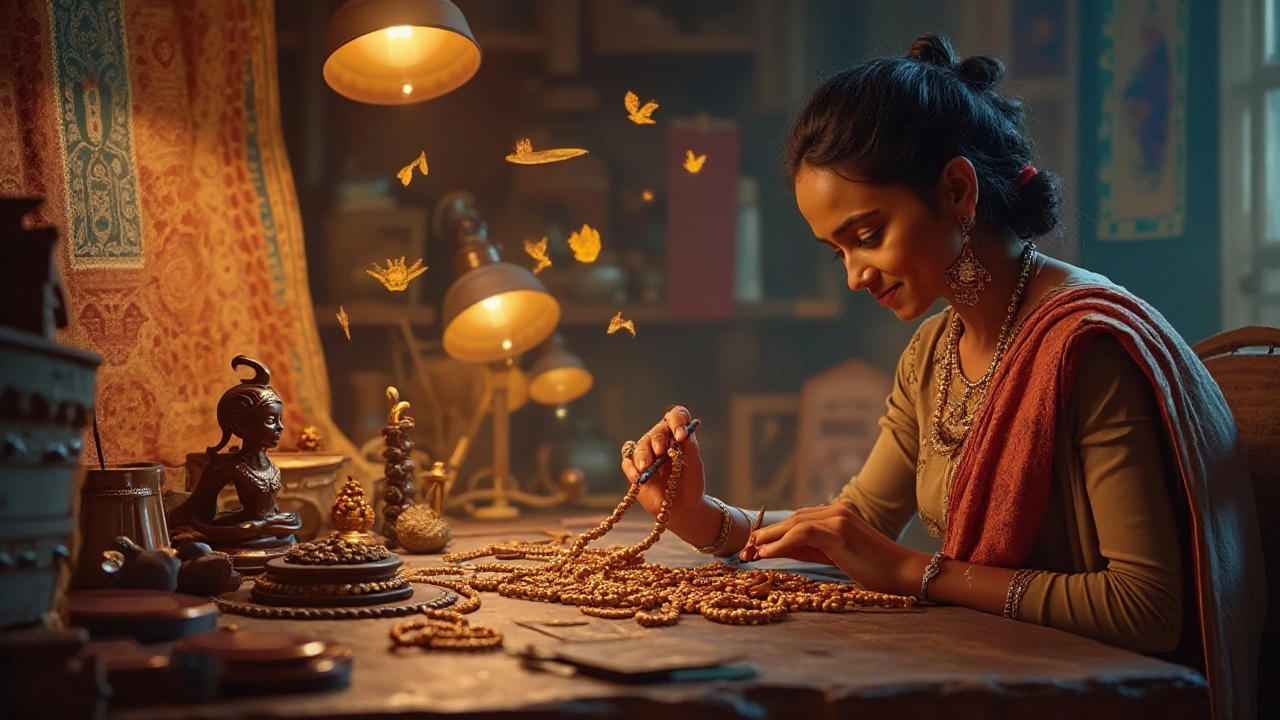
How to Choose the Perfect Mangalsutra
Choosing the perfect Mangalsutra is a journey that intertwines personal taste with cultural traditions. This sacred ornament, while deeply symbolic, also allows room for personal expression through a vast array of styles and designs available today. When selecting your Mangalsutra, consider the material of the thread and the design of the pendant, which are central to its look and feel. Traditionally, a Mangalsutra features a black bead chain with a gold pendant. These black beads are said to ward off evil, while gold is a symbol of prosperity. However, contemporary designs have diversified, incorporating diamonds, colorful beads, and even semi-precious stones, offering an every-day elegance suitable for modern lifestyles.
A critical factor is the length of the sacred thread. Typically, a Mangalsutra should fall at the bust line for a classic look, but shorter lengths are becoming popular for those who prefer a minimalist approach. Reflecting on your wardrobe and daily wear can guide you toward a choice that complements your personal style. Many women today opt for designs that seamlessly integrate with both traditional and contemporary attire, ensuring versatility and frequent wear.
Considering Regional Influences
Regional variations vastly influence the design choices of a Mangalsutra. For instance, the Solomon design from Bengal combines intricacy with cultural motifs, offering a rich tapestry of artistry in its beads and pendant. In contrast, the Maharashtrian style, often composed of two vatis or bowls, symbolizes marital unity distinctively. Whatever your choice, it's fascinating to see how regional styles echo personal and communal stories. Understanding these differences can significantly enhance your appreciation and help you select a piece that resonates with your heritage.Practical Aspects and Trends
Practicality and current trends are also worthy considerations. An increasing number of jewelers now propose designs that are lightweight yet robust, suitable for everyday use. A Mangalsutra must be durable, as it's often worn daily. It's advisable to inspect the clasp and chain strength when shopping. Durability is not the sole factor though: many modern brides look towards evolving trends such as detachable pendants or modular designs that allow customization based on occasion."While traditions hold value, embracing a form of marital bond that aligns with your lifestyle speaks volumes about modern-day cultural evolution," notes Anushka Sharma, a notable jewelry designer.
Whether you are graced with heirloom pieces or browsing bespoke creations, choosing a Mangalsutra is a harmonious blend of honoring legacy and expressing individuality. Ultimately, the ideal Mangalsutra should reflect personal meaning, its knots and beads intertwining love and tradition into the daily narratives of women across generations.
Caring for Your Mangalsutra
Taking care of your Mangalsutra is crucial to ensure it remains as beautiful and significant as the day it was first adorned around your neck. This piece of jewelry is intricate and often composed of precious metals like gold, sometimes adorned with black beads and other embellishments, symbolizing the longevity and prosperity of your marital life. Due to its importance, both symbolically and materially, regular maintenance is necessary to preserve its elegance and spiritual sanctity.
To keep the Mangalsutra in pristine condition, routine cleaning is essential. The accumulation of dirt, sweat, and oils from the skin can dull its shine over time. Begin by gently soaking your Mangalsutra in a mild soap solution; use lukewarm water to avoid any damage to the metal. After soaking for about fifteen minutes, take a soft-bristled brush, something like a toothbrush, and gently scrub the chain and beads. Pay attention to the delicate details, ensuring you’re not too rough as to damage the inherent design. Rinse thoroughly in clean water to remove any soap residues. Dry completely with a soft cloth before storing it away.
Proper storage also plays a significant role in maintaining the elegance of this sacred ornament. Always store your Mangalsutra in a dry, cool place inside a soft cloth or a dedicated jewelry box. This not only prevents it from acquiring scratches but also protects against the harsh effects of humidity and sunlight, which can cause discoloration or fading of the beads and gold components. Additionally, keep it away from direct contact with perfumes or harsh chemicals. The chemicals can react with the metal, leading to tarnishing and weakening the overall structure.
Many jewelers also recommend periodic professional cleaning and maintenance where they can inspect the integrity of the chain and the clasps.
"Jewelry is a timeless artifact, and its care reflects the respect you bear for tradition," states renowned jewelry designer Sayuri Shrivastava. Regular checks by an expert can help in identifying issues, such as loose beads or weakened threads, preventing any loss or damage during wear. By following these steps, you not only maintain the Mangalsutra’s brilliance but also continue to honor its cultural and spiritual essence.
Should you ever find yourself needing repairs or updates, opt for trusted jewelers who understand the significance and craftsmanship of the Hindu sacred thread. Whether it’s resizing or repairing a broken chain, professional assistance ensures the Mangalsutra’s authenticity and sentiment remain intact. Remember, as the years go by, this piece will not only continue to be a part of your attire but also a timeless testament to your journey together as partners. Thus, caring for it reflects your commitment to both tradition and to your unique relationship.
